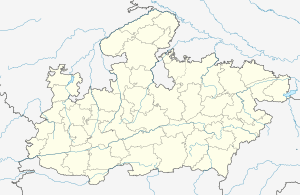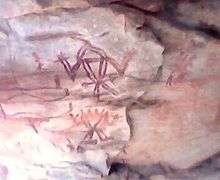Bhanpura
Bhanpura is a town and a nagar panchayat in Mandsaur district, located in the state of Madhya Pradesh, India. Bhanpura was discovered by King Bhanu bhil। It was also ruled by the Chandrawats of Mewar during the times of Rana Sanga's rule. The town is home to a number of historic places such as the Daraki-Chattan region, which is one of the world's oldest rock arts,[1] Chaturbhujnath Nala rock art shelters, and the Hinglajgarh Fort. Bhanpura also has a museum that displays the popular arts of Mandsaur, including art from the Gupta era (4th–5th century) until the time of Pratiharas and Parmaras.[2]
Bhanpura | |
|---|---|
city | |
 Bhanpura Location in Madhya Pradesh, India | |
| Coordinates: 24.52°N 75.73°E | |
| Country | India |
| State | Madhya Pradesh |
| District | Mandsaur |
| Elevation | 384 m (1,260 ft) |
| Population (2001) | |
| • Total | 16,493 |
| Languages | |
| • Official | Hindi |
| Time zone | UTC+5:30 (IST) |
History
Archaeological evidence
The excavation at Daraki-Chattan revealed immense information on the cultural occupation of the site. Daraki-Chattan is a small and narrow cleft or cave in the tall cliff faces of Indragarh Hill in the Vindhya range, overlooking the Rewa river valley.[3] The cave is approximately 1.4 metres (4.6 ft) wide at its mouth, from where it continuously narrows down in width, finally closing at the depth of 8.4 m (28 ft) from its mouth. The cave is approximately 7.4 m (24 ft) in height.[4] It bears more than five hundred deeply patinated cupules on both of its vertical walls.[5] The Daraki-Chattan cupules were discovered by Ramesh Kumar Pancholi in 1992. The Archaeological Survey of India took up Daraki-Chattan region near Bhanpura as a case for the study of early petroglyphs in India, and commenced excavation under Giriraj Kumar in 2002.[6]
Daraki-Chattan reveals the past of an extensive rock art in this cave. The collection of stone artifact assemblage from the excavation undoubtedly reveals that the shelter was occupied by the Acheulean man. The experts studying the petroglyphs claim it to be the "oldest rock art in the world", about 2 to 5 lakh (200,000–500,000) years old.[7]

In order to study the early cupules in India, an international project called "Early Indian Petroglyphs" was established in 2000. It is a joint venture by researchers from Rock Art Society of India (RASI) and Australian Rock Art Association (AURA), under the supervision of the International Federation of Rock Art Organizations (IFRAO), Robert Bednarik and Giriraj Kumar.[3]

Modern history
Bhanpura gets its name from a king named Bhaman.[2] It was ruled by the Chandrawats of Mewar in the 16th century. Chandrawat of Bhanpura held the title of 'Rao'. The Chandrawats descend from Chanda Singh, and were powerful chiefs in Mewar. They migrated from Mewar due to internal strife. At that time, Maharaja Yashwantrao Holkar, who was a strong nationalist, decided to drive the British out of India. After successfully keeping the British out of his state, he built 200 cannons at a factory in Bhanpur. He gathered an army of 1 lakh (100,000) soldiers to attack Calcutta. The stress of the work and the death of his nephews, Khanderao Holkar II on 3 February 1806 at Shahapura, and Kashirao Holkar in 1808 at Bijagad, led to his sudden death in Mandsaur on 28 October 1811 at the age of 35.[8]
A Chhatri was constructed on the site of death of Maharaja Yashwantrao Holkar in Bhanpura, completed in 1841. This Chhatri houses a marble statue of Maharaja Yashwantrao Holkar. The ruins of the cannon factory can be seen in villages of Navali and Indragarh near Bhanpura.[9]
Geography
Bhanpura is located at 24.52°N 75.73°E.[10] It has an average elevation of 384 metres (1,259 feet). Bhanpura is 127 km (79 mi) north-east of Mandsaur, and south of Hinglajgarh and Navali in Mandsaur district.
Demographics
As of 2001 India census,[11] Bhanpura had a population of 16,493. Males constituted 51% of the population and females 49%. Bhanpura had an average literacy rate of 70%, higher than the national average of 59.5%; with male literacy of 80% and female literacy of 61%. 13% of the population was under 6 years of age.
Tourism
Bhanpura museum
The Chhatri of Yashwantrao Holkar houses a museum of popular arts of Mandsaur. Art from the Gupta era (4th–5th century) until the time of Pratiharas and Parmaras is on display. Sculpted portraits of Uma-Maheshwar, Kartikeya, Vishnu, Gavoi and Nandi are also displayed.[2]
The Bhanpura Museum has a collection of statues gathered from the nearby areas. The statues include depictions of Chamunda, Mahishasuramardini, Parshwanath, gauri, Ardhanarishwara, and Chaturbhuja Vishnu. The 11th-century Nandi statue is very attractive. In front of the Nandi, there is a male and a female figure and laddus in a plate. Another statue of great importance is that of Uma-Maheshwar which is adorned with ornaments, in which Uma-Maheshwar is depicted as riding the Nandi. The museum houses the archaeological material found during construction of Gandhi sagar dam. There is also a collection of arms and ammunition from historic wars. Oil paintings from around Bhanpura have been displayed here.[9] The Nandi and Uma-Maheshwar sculptures have been loaned to France and Washington, D.C. for display in Indian art festivals.[12]
Hinglajgarh Fort
Hinglajgarh or Hinglaj Fort is an ancient fort situated near Navali village in the Bhanpura tehsil of Mandsaur district in Madhya Pradesh. It is located at 25°30' N 65°31' E. It is situated at a distance of 165 km (103 mi) from Mandsaur and 26 km (16 mi) from Bhanpura in Madhya Pradesh.[13] This fort was at its peak of grandeur during the Parmara rule.[14] There are many artistic sculptures of various periods in this fort. The Nandi and Uma-Maheshwar sculptures were sent from here to France and Washington for display in Indian festivals.[12] Hinglajgarh has been the centre of excellence in craftsmanship of sculptures for about 800 years. The statues recovered from this fort are from Gupta period to the Parmara period. The most ancient statues are from 4th to 5th century AD.[15]
Chaturbhujnath Nala rock art shelters
Chaturbhujnath Nala rock art shelters were discovered in 1973,by Dr. Ramesh kumar pancholi[16] and are one of the Longest Rock Art Galleries in the world.[7] They are situated near the Gandhi Sagar Sanctuary, 30 kilometres (19 mi) from Bhanpura in the Mandsaur district of Madhya Pradesh. It is located along a perennial stream called the Chaturbhujnath Nala, stretching in a 5-kilometre-long (3.1 mi) rock art gallery, with thousands of figures painted on its walls. According to carbon dating, the paintings are around 35,000 years old.[16] The rock shelters differ from the rock caves of Bhimbetka, because they are isolated and relatively narrow.
The surface of the paintings is uneven in colour and texture. The colour of the paintings, which is mostly red and ochre, comes in varying shades, some bright, others a faded maroon and in rare instances, white and black.[17] The subjects of paintings are human beings and animals including elephants, bison, tigers, leopards, monkeys, snakes, birds, rhinos, deer, water animals, foxes, cows, bullocks and camels. In several cases, daily lives have been depicted, such as herding, hunting, axe wielding, riding cattle, women performing chores, and other pastoral arts. The people, usually men, are sometimes depicted as stick figures, and sometimes using two triangles linked by straight lines, with or without clothes.[17]
In January 2007, the Rock Art Society of India (RASI) described it as the "longest chain of rock arts in the world". According to them, the earliest carvings are mostly of animals. RASI Secretary G L Badam stated, "The presence of a variety of rituals, processions and fighting scenes goes to prove the continuity of the art and early man's culmination into community living".[18]
Gandhi Sagar Sanctuary
Gandhi Sagar Sanctuary is a wildlife sanctuary situated on the northern boundary of Mandsaur and Nimach districts in Madhya Pradesh, India. It is spread over an area of 368.62 km2 (142 sq mi) adjoining the state of Rajasthan in India. It was created in 1974 and expanded in 1983. The Chambal River passes through the sanctuary and divides it into two parts: the western part is in Nimach district and the eastern is in Mandsaur district.
Kethuli Jain Temple
Kethuli Jain temple is 21 km (13 mi) from Bhanpura, on the road towards Jhalrapatan. It is a famous 'Atishay Kshetra' attracting Jain pilgrims. The temple has a 500 year-old idol of Tirthankara Parshvanatha.
Kathiriya waterfall
Education
Bhanpura has several educational institutions. There are many professional computer institutes and industrial training Institutes, and many colleges. Saraswati Vidya Mandir is a Hindi medium school. The residential C.B.S.E. affiliated school of the district is Smt Kamala Saklecha Gyan Mandir, which is situated 4 km (2.5 mi) away from Bhanpura.
References
- "Madhya Pradesh houses world's oldest rock art: experts". The Hindu. PTI. 25 November 2016. ISSN 0971-751X. Retrieved 15 October 2018.CS1 maint: others (link)
- Madhya Pradesh A to Z: MPTDC March, 1994, p.53
- Foundation, Bradshaw. "Indian Rock Art - The Rock Art Site of Magazine Shelter". Bradshaw Foundation. Retrieved 16 October 2018.
- Giriraj, Kumar; Ram, Krishna (1 November 2014). "Understanding the Technology of the Daraki-Chattan Cupules: The Cupule Replication Project". Rock Art Research. 31 (2). ISSN 0813-0426.
- "Madhya Pradesh houses world's oldest rock art". Hindustan Times. 25 November 2016.
- "Daraki-Chattan Cave, Madhya Pradesh: Acheulian Cupule Site, c. 200,000 - 500,000 BP". originsnet.org. Retrieved 16 October 2018.
- "Experts dig deep into rock art history of MP's Bhimbetaka and other heritage sites". Hindustan Times. 10 April 2017.
- "Archived copy". Archived from the original on 1 March 2010. Retrieved 28 September 2009.CS1 maint: archived copy as title (link)
- Usha Agarwal:Mandsaur Zile Ke Puratatvik samarakon ki paryatan ki drishti se sansadhaniyata - Ek Adhyayan, Chirag Prakashan Udaipur, 2007, p. 34
- Falling Rain Genomics, Inc - Bhanpura
- "Census of India 2001: Data from the 2001 Census, including cities, villages and towns (Provisional)". Census Commission of India. Archived from the original on 16 June 2004. Retrieved 1 November 2008.
- Usha Agarwal:Mandsaur Zile Ke Puratatvik samarakon ki paryatan ki drishti se sansadhaniyata - Ek Adhyayan, Chirag Prakashan Udaipur, 2007, p. 38
- Rajendra Verma:Mandsaur District Gazetteer, p. 289
- Ramlal Kanwal:Prachin Malwa mein Vastukala, p. 185
- Usha Agarwal:Mandsaur Zile Ke Puratatvik samarakon ki paryatan ki drishti se sansadhaniyata - Ek Adhyayan, Chirag Prakashan Udaipur, 2007, p. 42
- "35,000-year-old rock painting rots in Bhanpura area of Madhya Pradesh - Times of India". The Times of India. Retrieved 16 October 2018.
- "The Untold Story of MP: Bhanpura, Chaturbhuj Nala and Hinglajgarh". Beyondlust. 13 May 2013. Retrieved 16 October 2018.
- T S Sreenivasa Raghavan (6 January 2007). "World's longest rock art chain in Vindhyas". The Times of India. Retrieved 7 January 2007.